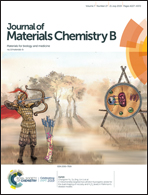A mitochondria-targeted two-photon fluorogenic probe for the dual-imaging of viscosity and H2O2 levels in Parkinson's disease models†
Abstract
Parkinson's disease (PD) is a neurodegenerative disease that seriously affects the quality of life of the patient. Many sources have shown that mitochondrial dysfunction is increasingly appreciated as playing a critical role in the pathogenesis of PD. The mitochondrial microenvironment and H2O2 level are two key parameters that are used to assess the function of mitochondria. Herein, we designed and synthesized a novel two-photon (TP) fluorogenic probe Mito-LX, which could simultaneously monitor changes in the mitochondrial viscosity and H2O2 levels using two different channels. This probe showed a significant response to viscosity changes with red emission at 730 nm and high sensitivity to H2O2 levels with orange emission at 585 nm. Moreover, Mito-LX was successfully applied to living systems (including living cells, zebrafish and Drosophila) for viscosity and H2O2 detection using one- and two-photon fluorescence confocal microscopy.



 Please wait while we load your content...
Please wait while we load your content...